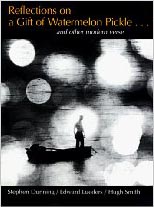|
 |
| Teachers.Net Gazette Vol.6 No.3 | March 2009 |
Subscribe for free home delivery |
|
Using Photography To Inspire Writing V | ||
| by Hank Kellner author of Write What You See: 99 Photographs To Inspire Writing author's blog
Continued from page 1 |
||
|
Mickey Mouse Lives!
“Mickey Mouse is, to me, a symbol of independence.” Those are the words of Walt Disney, the American cartoonist and filmmaker who created Mickey Mouse and a host of other memorable characters. Mickey made his debut in Steamboat Willie at the Colony Theatre on November 18, 1929, went on to star in 120 different cartoons, and also starred in “The Mickey Mouse Club”   Truth to tell, the image shown at the left doesn’t resemble Mickey Mouse, but it does offer students an opportunity to reflect on symbols as opposed to signs. The image on the right depicts a sign. Using similar images, you could ask your students to discuss the difference between symbols and signs before they write about them using examples they have photo-graphed or clipped from newspapers and magazines. Perhaps the students could compile annotated anthologies or create bulletin boards based on images of symbols and/or signs.
Comic Strips, Cartoons, and Working Lunches
Mary Lee Meyer is a Prairie Lands Writing Project Technology Liaison working as a PLWP teacher consultant. See writingwithtechnology.edublogs.org for examples of some of the activities she demonstrates at her writing workshops for teachers. In one activity, Meyer suggests using comic strips or political cartoons from newspapers and magazines to inspire student writing. “Scan an image into Microsoft Paint™ or another photo editing program and erase the words in the bubbles,” she writes. “Then print copies and ask the students to discuss the cartoon or comic strip in small group settings.” Meyer points out that this exercise helps students develop writing assignments that use dialogue. In another activity, Meyer asked workshop participants to take a working lunch during which they recorded at least five digital photos that they thought they could use in a writing assignment. “This was a two-day class,” she writes, “during which participants were required, among other things, to use one of their images appropriately in a written piece.” This assignment could easily be completed with students at any level in just one day if the students are directed to come to class with photos they had already taken.
Family Photos and Postcards
At the Ottawa Elementary School, Petoskey, Michigan, Alisa Santii uses family photos to connect with her students’ lives. “I ask the students to bring in photos showing family-oriented activities,” she writes. “Then I encourage them to write descriptive paragraphs that reveal more than just what is plainly seen in the photos. To this end, we urge them to generate ideas in terms of who, what, when, where, and how.” In another activity, Santii uses postcards or photos of various places as triggers for descriptive paragraphs. “After they write their descriptions,” she concludes, “the students read them to their classmates who must then draw pictures based on what they saw.”
Sharing Is Caring
Do you have a photo-related writing activity you’ve used successfully in the classroom? Would you like to share that activity with other teachers at many levels nationwide? If so, I’d love to hear from you. Please send approximately 100 words describing your activity to me at hankpix@gmail.com as a WORD attachment to your e-mail. Don’t forget to include your name, title, school or college, city, state, and a brief statement granting permission to use your submission in my articles. Thank you.
Copyright 2009 Hank Kellner
| ||
|



 Hank Kellner is a retired educator and the author of Write What You See: 99 Photographs to Inspire Writing. Original Edition. Cottonwood Press. I-800-864-4297
Hank Kellner is a retired educator and the author of Write What You See: 99 Photographs to Inspire Writing. Original Edition. Cottonwood Press. I-800-864-4297 